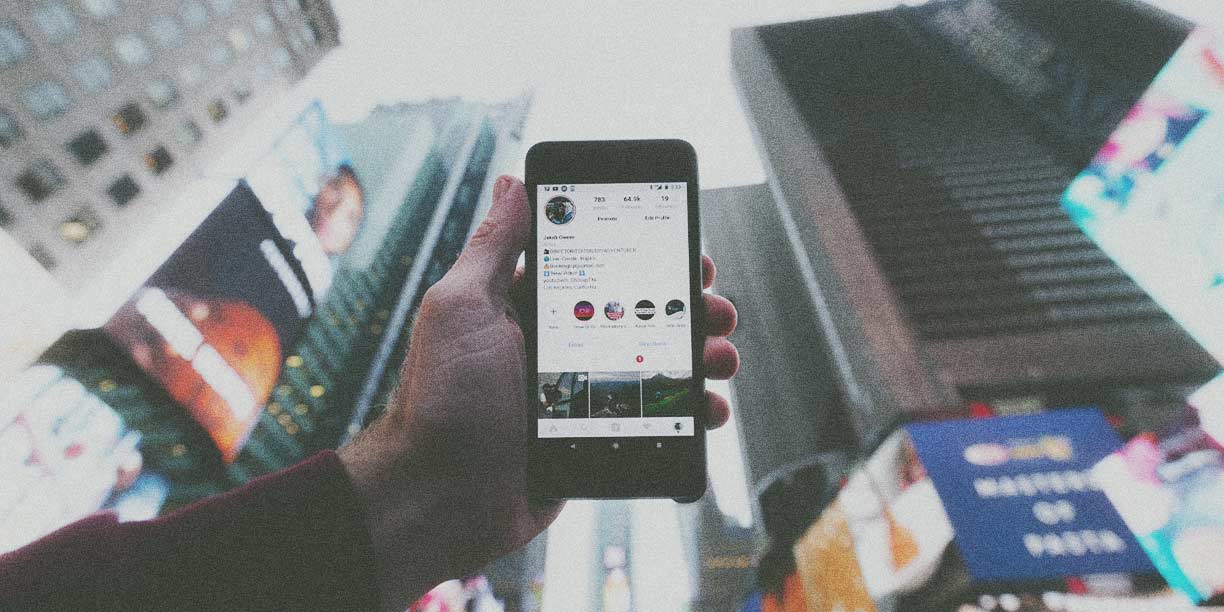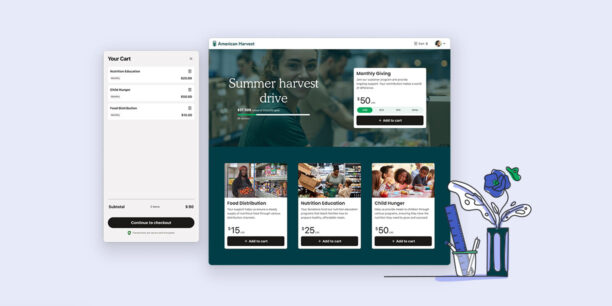Event Marketing: Your 3-Phase Approach to a Stronger Social Media Strategy

Request a Demo
Learn how top nonprofits use Classy to power their fundraising.
Around 4.26 billion people use social media—that’s roughly 57% of the world’s population.¹ In addition, 73% of marketers claim social media has been effective in elevating their businesses, which means there’s an opportunity for nonprofits to use social platforms for event promotion.²
Below, we’ll share some tips to help you improve how you use social media for events. We’ll cover how event organizers can use platforms like Instagram, LinkedIn, and Snapchat to build momentum pre-event, increase real-time engagement during the event, and improve future event management through post-event surveys and other touchpoints.
Your 10-Week Social Media Event Promotion Plan
In the months, weeks, and days leading up to your event, spread the news far and wide to ensure it’s on the radar of all potential attendees. Effective event promotion can drive registrations, ticket purchases, donations, and peer-to-peer fundraising sign-ups.
To get started, you’ll need to identify the:
- Social media channels you want to use
- Social media event marketing goals you want to reach
- Type of content you plan to share
Prioritize Your Social Media Channels
Each of the dominant social media platforms—Twitter, LinkedIn, Facebook, and Instagram—requires slightly different strategic approaches. For instance, Twitter only allows 280 characters, while others are unrestricted. A well-rounded social media marketing plan to promote your upcoming event will use all four platforms. However, you’ll likely want to prioritize one or two as your primary channels.
Select the social media channels your target audience uses most to be your primary focus. Additionally, look for a social media pairing that lets you balance content types.
For example, you might select Facebook and Instagram because your largest and most engaged following is on these platforms. You can use Facebook to provide plenty of details on your event, its story, and how it connects to your mission.
Classy + Facebook: Your Guide to Boosting Fundraiser Retention
You might also create a Facebook event, so supporters can save the date and easily find your registration page. Meanwhile, you can use Instagram to share quick graphics of your event poster, and Snapchat can help you push out imagery-driven event teasers.
Finally, you might also consider using social media tools like Eventbrite or Hootsuite to help schedule posts and drive traffic to your event registration page.
Set Your Social Media Event Goals
Clear SMART goals will help guide your social media marketing efforts. For example, you may want to use social media to:
- Increase attendance for your quarterly webinar
- Encourage participation in the virtual fundraising event component of your charity gala
- Track supporter engagement across platforms to target future social media promotions better
- Gain new social media followers likely to remain engaged post-event
- Drive ticket sales to support your larger fundraising goals
No matter what your goals are, solidify them before you start marketing your event. By doing so, your efforts will be more targeted and effective, and you’ll have a clear vision of what you want to accomplish.
Schedule Key Event Announcements and Deadlines on Social Media
It can be helpful to structure your pre-event social media promotion around a few crucial announcements or deadlines. For example, you might:
- Announce the date of your event
- Showcase the various activities happening at your event
- Reveal speakers or special guests
- Present your official event hashtag to your social channels
- Offer a giveaway for one free event registration
- Inform the public about deadlines for early-bird or VIP ticket sales
- Amplify excitement for the event through a countdown during the final pre-event week
Creating a social media posting schedule educates your audience on event details while repeatedly promoting your event in an organic, non-forced way.
Your pre-event social media marketing should focus on creating awareness for the event, driving registrations or ticket sales, and building excitement for what’s to come. However, on the day of your event, your objectives will shift to:
- Delight attendees on the ground
- Share posts on your channels to engage those who couldn’t make it
- Collect event content for future promotions
Since live event coverage is a big job, it helps to designate one person to handle it. This way, event organizers don’t have to stress about running the event while simultaneously capturing all its golden moments.
Delight Attendees to Entice Social Media Sharing
To ensure your event receives the awareness it deserves, encourage attendees to share posts about their experience on social media. Look for ways to surprise and delight your attendees to encourage them to talk about it online. For example, you can:
- Host a fun photo booth to capture the event’s vibe and create ready-to-share content
- Ask attendees to record short videos about their favorite moments
- Hand out branded swag with your event’s hashtag on it
- Announce sponsor and partner shoutouts throughout the event
As you post to your channels, also pay attention to what others say about your event. Like, share, and respond to positive posts to continue fueling the conversation.
However, if you come across any complaints or negative posts, don’t ignore them. Even if you don’t have an immediate solution, replying to these posts or privately messaging the attendee shows that you care and want to make things right. Also, these negative posts can alert you to problems that you may not even know exist.
Use Social Media for Your Virtual Event Audience
No matter how successfully you market your event on social media, there will be people who can’t attend in person, aren’t interested in participating, or are still unaware of it. Your day-of coverage is a prime opportunity to show them all the great things happening.
For people who can’t make it, your live coverage can play on their fear of missing out (FOMO) and ignite a sense of urgency to be present for the next event. It’s also a chance to re-appeal to those who didn’t want to go—maybe they realize it’s a more impactful event than they initially thought and now want to get involved.
Finally, for those who were unaware, this lets you market the event to them again and drive their attention back to your nonprofit. Use your social media posts during the event to nurture relationships and start new ones, all while marketing your impact.
Virtual event platforms for nonprofits make it easier than ever to host a hybrid event and engage those who can’t join in person. Of the many benefits, you’ll be able to livestream any presenters, including your keynote speaker.
Collect Event Content for Future Social Media Efforts
Nonprofit content marketing and social media marketing go hand in hand. Your event can help generate content for blog posts, special email blasts, future social media posts, and more.
Ask your entire team to capture content, like photos, videos, and attendee testimonials, on the day of your event. Then, post-event, they can upload it into a shared folder. It’s also a good idea to have a specific list of images or videos you want to capture beforehand to ensure you get them.
Finally, while it’s critical to have a plan walking into your event, be flexible with your day-of social strategy to capitalize on in-the-moment content that organically comes your way. If you pay attention, you can capture these authentic moments for future use.
The final phase of effective social media event marketing occurs after your event. You’ll want to:
- Thank your attendees and reflect on the event
- Analyze key social media event metrics
- Send a post-event survey
Use Social Media to Thank Event Attendees
First and foremost, after an event, use your social media channels to thank donors and attendees for making the event possible. You might want to do a few separate posts for different groups, such as:
- Sponsors
- Partners
- Volunteers
- Attendees
- Major donors
If you have individuals’ or sponsors’ social media handles, you can tag them in the posts to ensure they see them and encourage re-sharing.
You can also take this post-event time to reflect on the event with an attitude of gratitude. Share a recap or wrap-up post that highlights five or six key moments from the event. Pair this with a few high-resolution photos of each moment.
Analyze Social Media Event Metrics
Following your event, review your social media data to inform your marketing strategy for future events. You’ll want to consider:
- Which platforms led to the most registrations, user-generated content, donations, and overall engagement
- Which content types drove the most engagement (e.g., photos, links, text messages, etc.)
- How engagement varied on different social media channels before, during, and after the event
Understanding how effective your social media event marketing was will help zero in on your efforts to increase engagement and participation for your next event.
Send a Post-Event Survey for Greater Social Media Insights
In addition to reviewing your social media metrics, ask your audience for their input. A post-event survey can help you further understand:
- How your supporters want to engage with you on social media
- What type of content resonates most with them
- How they heard about your event
- What communication styles they prefer
Soliciting supporter feedback is extremely valuable for planning future events. You’ll know which social media strategies to double down on or improve next time.
Once you’ve reviewed your survey data, use it as a donor touchpoint. Reach out to your supporters to let them know what you learned and any changes you’ll make as a result. Doing so demonstrates that you value their feedback and hold yourself accountable to continuous improvement.
Social media marketing is a crucial cornerstone of your event’s success, so treat it as you would any other facet of your strategy: with time and due diligence. That’s where Classy comes in. For even more tips, download our Social Media Marketing Guide below.
Article Sources
- “Number of Social Media Users Worldwide From 2017 to 2027,” Statista, last modified January 24, 2023, https://www.statista.com/statistics/278414/number-of-worldwide-social-network-users/.
- “State of Social 2019,” Buffer, accessed January 26, 2023, https://buffer.com/state-of-social-2019.

The Social Media Marketing Guide for Nonprofit Events
Subscribe to the Classy Blog
Get the latest fundraising tips, trends, and ideas in your inbox.
Thank you for subscribing
You signed up for emails from Classy
Request a Demo
Learn how top nonprofits use Classy to power their fundraising.
 Explore Classy.org
Explore Classy.org 

